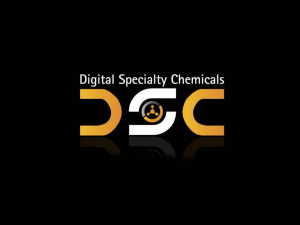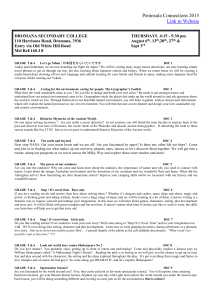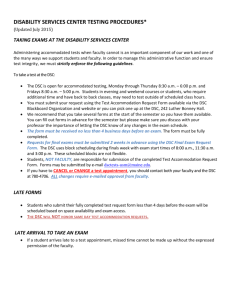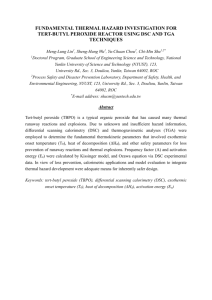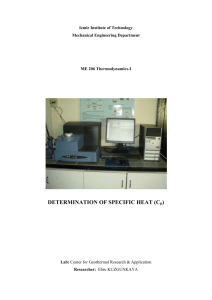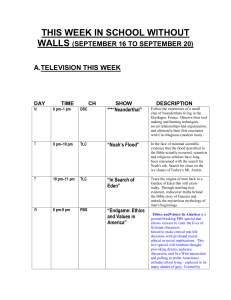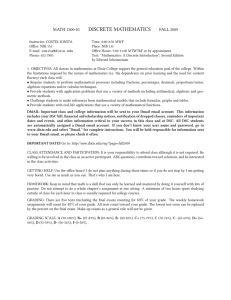ME4331-1
advertisement
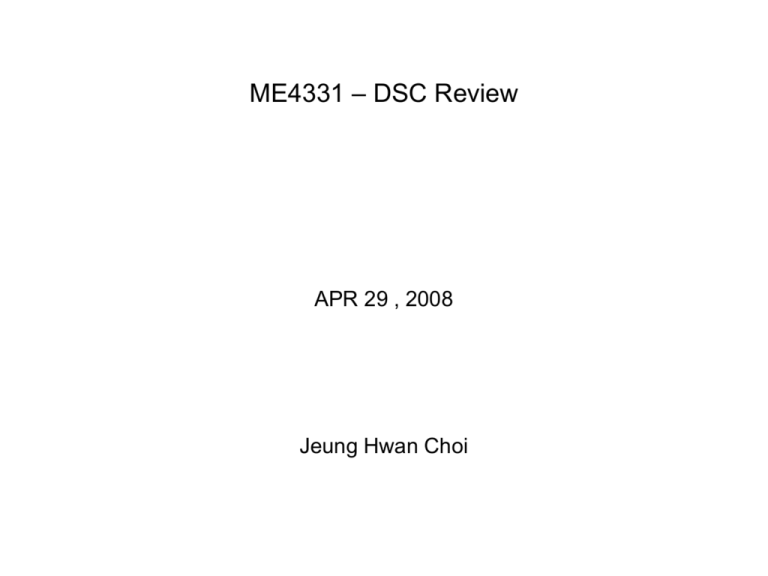
ME4331 – DSC Review APR 29 , 2008 Jeung Hwan Choi CALORIMETRY Calorimetry - The science of counting the heat of chemical reactions or physical changes. - In constant-pressure calorimetry, the heat measured represents the enthalpy change. Differential Scanning Calorimetry Differential Scanning Calorimetry (DSC) is a thermal analysis method in which the difference in the amount of heat applied (or removed) to increase (or decrease) the temperature of a sample material and a reference material are measured as a function of temperature. - Höhne et al. (1996) Differential Scanning Calorimetry - Perkin Elmer, Inc. - Wikipedia.org DIFFERENTIAL SCANNING CALORIMETER - The DSC will maintain the temperatures of the sample and reference equal during a scan (change of both materials from one temperature to another). - The Pyris1 Differential Scanning Calorimeter allows the user to change the temperature at a prescribed constant rate (linear temperature control). sample furnace reference furnace - Höhne et al. (1996) Differential Scanning Calorimetry - Perkin Elmer, Inc. DSC – ENDOTHERMIC VS. EXOTHERMIC - When the sample undergoes a physical transformation such as phase transitions, more (or less) heat will need to flow to it than the reference to maintain both at the same temperature. - This noticeable difference results in the appearance of an upper or lower peak, depending on whether the transformation is exothermic or endothermic. - A solid sample melting to a liquid will require more heat flowing to the sample to increase its temperature at the same rate as the reference, and is an example of an endothermic process. - If a liquid crystallizes into a solid during a cooling scan, more heat would have to be removed compared to the reference and is an example of an exothermic process. - Höhne et al. (1996) Differential Scanning Calorimetry - Perkin Elmer, Inc. DSC – MELTING POINT • Melting point measurement heating rate = 5 °C/min - Melting point of a pure substance (i.e. ice) is the onset temperature - Onset is determined from the intersection of the slopes of the base and the rising curve Reference : Höhne et al. Differential Scanning Calorimetry 1996 Perkin Elmer, Inc. DSC outline – latent heat DSC - LATENT HEAT • Latent heat of fusion of ice Reference : CRC Handbook of Chemistry and Physics 2007 DSC outline – latent heat DSC - LATENT HEAT • Latent heat measurement Possible errors heating rate = 5 °C/min - Weight value - Evolution width - Baseline error (Instrument based) - Baseline error (sample based) t T T2 1 Power Compensation 1 2 dH 1 2 dH dt dT h dt dT m T Heat (Cool )ing Rate m t1 dt m T1 dt dT 1 Reference : Höhne et al. Differential Scanning Calorimetry 1996 Perkin Elmer, Inc. DSC outline – latent heat DSC - BASELINE • Selecting a baseline Standard (linear) Horizontal (from left) Sigmoidal Horizontal (from right) Linear baseline suffices for samples that : - are small in weight / volume - have a small specific transition energy - undergo a slow scanning rate Otherwise, sigmoidal baseline gives a good result Reference : Höhne et al. Differential Scanning Calorimetry 1996 Perkin Elmer, Inc. DSC outline – latent heat DSC - SPECIFIC HEAT • Specific heat of ice / water Reference : CRC Handbook of Chemistry and Physics 2007 DSC outline – specific heat DSC - SPECIFIC HEAT • Specific heat measurement Red : with water Blue : empty heating rate = 5 °C/min 1 dH 1 dH dt 1 Power Compensation cp m dT m dt dT m Heat (Cool )ing Rate Reference : Höhne et al. Differential Scanning Calorimetry 1996 Perkin Elmer, Inc. DSC outline – specific heat Green : specific heat DSC – PHASE DIAGRAM • System NaCl-H2O Phase Diagram DSC outline – specific heat DSC – PHASE DIAGRAM • 1xNaCl Thermal Analysis DSC outline – specific heat DSC – PHASE DIAGRAM • 5xNaCl Thermal Analysis DSC outline – specific heat DSC – PHASE DIAGRAM • 10xNaCl Thermal Analysis DSC outline – specific heat DSC – PHASE DIAGRAM • 23.3%(w/w) NaCl Thermal Analysis DSC outline – specific heat DSC – PHASE DIAGRAM • NaCl+H2O Thermal Analysis DSC outline – specific heat DSC – PHASE DIAGRAM • NaCl+H2O Thermal Analysis DSC outline – specific heat CRYOMICROSCOPY • Visualization of freeze-thaw events microscope LN2 dewar video text overlay cooling pump computer interfaced temperature controller cryostage Reference : Linkam Scientific Instruments Cryomicroscopy - layout CRYOMICROSCOPY • Growth of Primary Ice Video credits : Bumsoo Han DSC outline – specific heat CRYOMICROSCOPY • Solidification of the Eutectic Video credits : Bumsoo Han DSC outline – specific heat EUTECTIC SOLIDIFICATION • Phase change behavior in salt solutions (10xPBS) pre-eutectic @ -26°C Photo credits : Adam Grovender ADD: 10xPBS eutectic (photo) eutectic @ -26°C (after supercooling) DSC CAL • Diamond DSC 5C/min calibrations : - Baseline Curvature Calibrations - Baseline Slope Calibrations - Sample Temperature Calibrations - Furnace Calibrations - Heat Flow Calibrations DSC CAL • Diamond DSC 5C/min calibrations : Baseline Curvature - minimize amplitude of curve for operating temp. range Factory default Coarse control : + 1 Fine control : + 3 DSC CAL • Diamond DSC 5C/min calibrations : Baseline Curvature - minimize amplitude of curve for operating temp. range Factory default Fine control : + 14 Fine control : + 10 Fine control : + 13 Fine control : + 15 Fine control : + 20 DSC CAL • Diamond DSC 5C/min calibrations : Baseline Slope - minimize slope of curve for operating temp. range Factory default FSlope : - 3 Slope : - 5 Slope : + 5 Slope : - 4 DSC CAL • Diamond DSC 5C/min calibrations : Sample Temp. Cal. - Correctly predict transition temperatures of standards n-Decane : Expected = -29.66 , Measured = -31.73 Scyclohexane : Expected = -87.06 & 6.54 , Measured = -87.1 & 5.2 DSC CAL • Diamond DSC 5C/min calibrations : Furnace Calibration - 9-point temperature calibration between upper and lower temp. range - matches platinum resistance thermometer and programmed temp. -150.04 -125.01 -100.02 -75.02 -50.05 -24.93 -0.002 24.99 49.99 75.01 99.99 DSC CAL • Diamond DSC 5C/min calibrations : Heat Flow Calibration - match enthalpy values with known reference materials n-Decane : H = 202.09 vs 201.19 +/- 0.5, -0.45% T = -29.66 vs -29.66 +/- 0.04 DSC CAL • Diamond DSC 5C/min calibrations : Heat Flow Calibration - match enthalpy values with known reference materials H2O : H = 333.8 vs 338.6 +/- 0.15, +1.07% T = 0 vs -0.43 +/- 0.01 END OF SLIDES
